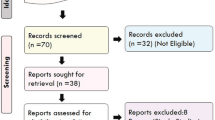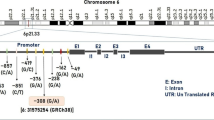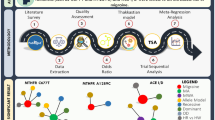Abstract
With a feature of complex pathogenic mechanisms, migraine is a well-known common neurovascular disorder. Multiple genes are responsible for hindering the susceptibility of pain threshold one of which is the eNOS gene and its variants. Multiple independent observational studies with case–control design produced conflicting findings, which can be attributed to a variety of factors including varying sample sizes, demographic stratification, technique application, etc. Therefore, in the present study we aimed to find out the precise risk between the selected variant of eNOS and the risk of migraine and its clinical subtypes using a meta-analysis approach. To find the association between the risk variants of the eNOS gene and migraine, a PRISMA-based systematic literature review strategy was utilized to search via online resources including PubMed and Google Scholar. Using several genetic models, odds ratios with 95% confidence intervals were computed to pool the data. To access heterogeneity, Cochran's Q Test and I2 statistics were utilized, while Begg's and Egger's tests were used to determine publication bias. A p-value of 0.05 or below was deemed statistically significant for all two-sided tests. The present meta-analysis was able to find out the significant protective association between rs743506 and migraine after using dominant (OR: 0.66, CI [0.49–0.86]), over-dominant (OR: 0.56, CI [0.42–0.75]), codominant model (OR: 0.58, CI[0.43–0.77]). Only significant risk association was found between rs1799983, rs3918226, and risk of migraine with aura after utilizing recessive and codominant models i.e., HR vs HW and HR vs HT. The present meta-analysis showed that rs743506 showed a protective association in comparison to rs1799983, rs3918226 which showed significant risk in the MA group. Also, TSA showed non-significant results and therefore, in conclusion, more studies are required to establish risk.
Graphical Abstract










Similar content being viewed by others
Data Availability
All data generated or analyzed during this study are included in this article. Further inquiries can be directed to the corresponding author.
Abbreviations
- ICHD-3 :
-
International Classification of Headache Disorder 3rd edition
- MA :
-
Migraine Aura
- MWA :
-
Migraine without Aura
- eNOS :
-
Endothelial Nitric Oxide Synthase
- ICHD-3 :
-
International Classification of Headache Disorders
- NCBI :
-
National Centre for Biotechnology Information
- MEDLINE :
-
Medical Literature Analysis and Retrieval System Online
- PRISMA :
-
Preferred Reporting Items for Systematics Reviews and Meta-Analysis
- IHS :
-
International Headache Society
- HWE :
-
Hardy-Weinberg Equilibrium
- OR :
-
Odds Ratio
- CI :
-
Confidence Interval
- I 2 :
-
I Square
- GAS :
-
Gene Association Study
References
Alderton WK, Cooper CE, Knowles RG (2001) Nitric oxide synthases: structure, function and inhibition. Biochem J 357(Pt 3):593–615. https://doi.org/10.1042/0264-6021:3570593
Bahadir A, Recep ERÖZ, Dikici S (2012) Düzce İli Migren Tanısı Almış Hastalarda ENOS Ekzon (G894T) Polimorfizminin Araştırılması. Duzce Med J 14(3):22–27
Borroni B, Rao R, Liberini P, Venturelli E, Cossandi M, Archetti S, Caimi L, Padovani A (2006) Endothelial nitric oxide synthase (Glu298Asp) polymorphism is an independent risk factor for migraine with aura. Headache 46(10):1575–1579. https://doi.org/10.1111/j.1526-4610.2006.00614.x
Chen K, Pittman RN, Popel AS (2008) Nitric oxide in the vasculature: where does it come from and where does it go? A quantitative perspective. Antioxid Redox Signal 10(7):1185–1198. https://doi.org/10.1089/ars.2007.1959
Chen M, Tang W, Hou L, Liu R, Dong Z, Han X, Zhang X, Wan D, Yu S (2015) Tumor necrosis factor (TNF) -308G>A, nitric oxide synthase 3 (NOS3) +894G>T polymorphisms and migraine risk: a meta-analysis. PLoS ONE 10(6):e0129372. https://doi.org/10.1371/journal.pone.0129372
Dong H, Wang ZH, Dong B, Hu YN, Zhao HY (2018) Endothelial nitric oxide synthase (-786T>C) polymorphism and migraine susceptibility: a meta-analysis. Medicine 97(36):e12241. https://doi.org/10.1097/MD.0000000000012241
Eröz R, Bahadir A, Dikici S, Tasdemir S (2014) Association of endothelial nitric oxide synthase gene polymorphisms (894G/T, -786T/C, G10T) and clinical findings in patients with migraine. Neuromol Med 16(3):587–593. https://doi.org/10.1007/s12017-014-8311-0
Förstermann U, Sessa WC (2012) Nitric oxide synthases: regulation and function. Eur Heart J 33(7):829–837d. https://doi.org/10.1093/eurheartj/ehr304
García-Martín E, Navarro-Muñoz S, Rodriguez C, Serrador M, Alonso-Navarro H, Calleja M, Turpín-Fenoll L, Recio-Bermejo M, García-Ruiz R, Millán-Pascual J, Navacerrada F, Plaza-Nieto JF, García-Albea E, Agúndez JAG, Jiménez-Jiménez FJ (2020) Association between endothelial nitric oxide synthase (NOS3) rs2070744 and the risk for migraine. Pharmacogenomics J 20(3):426–432. https://doi.org/10.1038/s41397-019-0133-x
Gonçalves FM, Luizon MR, Speciali JG, Martins-Oliveira A, Dach F, Tanus-Santos JE (2012) Interaction among nitric oxide (NO)-related genes in migraine susceptibility. Mol Cell Biochem 370(1–2):183–189. https://doi.org/10.1007/s11010-012-1409-5
Gonçalves FM, Martins-Oliveira A, Speciali JG, Luizon MR, Izidoro-Toledo TC, Silva PS, Dach F, Tanus-Santos JE (2011) Endothelial nitric oxide synthase haplotypes associated with aura in patients with migraine. DNA Cell Biol 30(6):363–369. https://doi.org/10.1089/dna.2010.1152
Gruber HJ, Bernecker C, Lechner A, Weiss S, Wallner-Blazek M, Meinitzer A, Höbarth G, Renner W, Fauler G, Horejsi R, Fazekas F, Truschnig-Wilders M (2010) Increased nitric oxide stress is associated with migraine. Cephalalgia 30(4):486–492. https://doi.org/10.1111/j.1468-2982.2009.01964.x
Güler S, Gürkan H, Tozkir H, Turan N, Çelik Y (2015) An Investigation of the relationship between the eNOS Gene polymorphism and diagnosed migraine. Balkan J Med Genet 17(2):49–59. https://doi.org/10.2478/bjmg-2014-0074
Ishii M, Yahara M, Katoh H, Kawamura M, Shimizu S (2014) Polymorphisms of nitric oxide synthase and GTP cyclohydrolase I genes in Japanese patients with medication overuse headaches. Neurol Asia 19(3)
Kruuse C, Thomsen LL, Birk S, Olesen J (2003) Migraine can be induced by sildenafil without changes in middle cerebral artery diameter. Brain 126(Pt 1):241–247. https://doi.org/10.1093/brain/awg009
Kruuse C, Thomsen LL, Jacobsen TB, Olesen J (2002) The phosphodiesterase 5 inhibitor sildenafil has no effect on cerebral blood flow or blood velocity, but nevertheless induces headache in healthy subjects. J Cereb Blood Flow Metab 22(9):1124–1131. https://doi.org/10.1097/00004647-200209000-00010
Logan JF, Chakravarthy U, Hughes AE, Patterson CC, Jackson JA, Rankin SJ (2005) Evidence for association of endothelial nitric oxide synthase gene in subjects with glaucoma and a history of migraine. Invest Ophthalmol Vis Sci 46(9):3221–3226. https://doi.org/10.1167/iovs.05-0368
Martorell-Marugan J, Toro-Dominguez D, Alarcon-Riquelme ME, Carmona-Saez P (2017) MetaGenyo: a web tool for meta-analysis of genetic association studies. BMC Bioinformatics 18(1):563. https://doi.org/10.1186/s12859-017-1990-4
Messlinger K, Lennerz JK, Eberhardt M, Fischer MJ (2012) CGRP and NO in the trigeminal system: mechanisms and role in headache generation. Headache 52(9):1411–1427. https://doi.org/10.1111/j.1526-4610.2012.02212.x
Nathan C, **e QW (1994) Regulation of biosynthesis of nitric oxide. J Biol Chem 269(19):13725–13728
Olesen J (2008) The role of nitric oxide (NO) in migraine, tension-type headache and cluster headache. Pharmacol Ther 120(2):157–171. https://doi.org/10.1016/j.pharmthera.2008.08.003
Oliveira-Paula GH, Lacchini R, Tanus-Santos JE (2016) Endothelial nitric oxide synthase: From biochemistry and gene structure to clinical implications of NOS3 polymorphisms. Gene 575(2 Pt 3):584–599. https://doi.org/10.1016/j.gene.2015.09.061
Papasavva M, Vikelis M, Siokas V, Katsarou MS, Dermitzakis EV, Raptis A, Kalliantasi A, Dardiotis E, Drakoulis N (2023) Variability in oxidative stress-related genes (SOD2, CAT, GPX1, GSTP1, NOS3, NFE2L2, and UCP2) and susceptibility to migraine clinical phenotypes and features. Front Neurol 13:1054333. https://doi.org/10.3389/fneur.2022.1054333
Qin B, Cai L, Zhang W, Tang Z, Zheng Y (2016) Effects of rs1799983 and rs1800779 polymorphisms in the endothelial nitric oxide synthase gene on migraine susceptibility with and without aura: a meta-analysis. Int J Clin Exp Med 9(8):15467–15476
Sipahi T, Güldiken B, Kabayel L, Palabiyik O, Özkan H, Kiliç TO, Süt N, Turgut N (2013) Endothelial nitric oxide synthase and angiotensin converting enzyme gene polymorphisms in migraine patients. Noro Psikiyatri Arsivi 50(3):274–278. https://doi.org/10.4274/npa.y6665
Steiner TJ, Stovner LJ, Jensen R, Uluduz D, Katsarava Z, Lifting The Burden: the Global Campaign against Headache (2020) Migraine remains second among the world’s causes of disability, and first among young women: findings from GBD2019. J Headache Pain 21(1):137. https://doi.org/10.1186/s10194-020-01208-0
Sudershan A, Mahajan K, Singh K, Dhar MK, Kumar P (2022) The complexities of migraine: a debate among migraine researchers: a review. Clin Neurol Neurosurg 214:107136. https://doi.org/10.1016/j.clineuro.2022.107136
Sudershan A, Pushap AC, Younis M, Sudershan S, Bhagat S, Kumar H, Panjalyia RK, Kumar P (2023a) Neuroepidemiology study of headache in the region of Jammu of north Indian population: A cross-sectional study. Front Neurol 13:1030940. https://doi.org/10.3389/fneur.2022.1030940
Sudershan A, Younis M, Sudershan S, Kumar P (2023b) Migraine as an inflammatory disorder with microglial activation as a prime candidate. Neurol Res 45(3):200–215. https://doi.org/10.1080/01616412.2022.2129774
Sureda-Gibert P, Romero-Reyes M, Akerman S (2022) Nitroglycerin as a model of migraine: clinical and preclinical review. Neurobiol Pain (cambridge, Mass) 12:100105. https://doi.org/10.1016/j.ynpai.2022.100105
Tajehmiri A, Sadeghi H, Mehmandousti S, Kaveh N, Mohammadi F, Mazdapour M (2013) Association of the G894T polymorphism of the endothelial nitric oxide synthase gene with migraine: an Iranian case-control study. J Biol Today’s World 2:417–424
Toriello M, Oterino A, Pascual J, Castillo J, Colás R, Alonso-Arranz A, Ruiz-Alegría C, Quintela E, Montón F, Ruiz-Lavilla N (2008) Lack of association of endothelial nitric oxide synthase polymorphisms and migraine. Headache 48(7):1115–1119. https://doi.org/10.1111/j.1526-4610.2008.01181.x
Tran N, Garcia T, Aniqa M, Ali S, Ally A, Nauli SM (2022) Endothelial nitric oxide synthase (eNOS) and the cardiovascular system: in physiology and in disease states. Am J Biomed Sci Res 15(2):153–177
Tutunchi S, Akhavan S (2016) Evaluation of NOS3 gene rs1800779 polymorphism in Iranian patients affected by migraine and normal individuals. Adv Biores 7(5)
Zakerjafari M, Dehkordi FF, Yaghoubi H (2016) Evaluation of NOS3 T-C 786 gene polymorphism in Iranian patients affected by migraine and normal individuals. Adv Biores 7:16–19
Zinck T, Illum R, Jansen-Olesen I (2006) Increased expression of endothelial and neuronal nitric oxide synthase in dura and pia mater after air stress. Cephalalgia 26(1):14–25. https://doi.org/10.1111/j.1468-2982.2005.00978.x
Acknowledgements
The authors are highly thankful to the Institute of Human Genetics, University of Jammu, and Department of Human Genetics (Sri Pratap College, Srinagar, Cluster University Srinagar) for support in the present study.
Funding
This research did not receive any specific grant from funding agencies in the public, commercial, or not-for-profit sectors.
Author information
Authors and Affiliations
Contributions
Detail of the author’s contribution, according to the CRediT (Contributor Roles Taxonomy) System: PK & AS conceptualized the study and provided supervision, M.B, A.C.P &KSdownloaded and filtered the data, AS, KSconducted all the statistical analysis, and interpretation. A.Sdrafted the manuscript, pictures, and tables editing, HK & PK edited the manuscript and PK finalized the manuscript. All authors provided critical feedback on drafts and approved the final manuscript.
Corresponding author
Ethics declarations
Ethics Approval and Consent to Participate
Not applicable.
Consent for Publication
Not applicable.
Conflict of Interest
The authors declare that they have no conflict of interest.
Additional information
Publisher's Note
Springer Nature remains neutral with regard to jurisdictional claims in published maps and institutional affiliations.
Supplementary Information
Below is the link to the electronic supplementary material.
Rights and permissions
Springer Nature or its licensor (e.g. a society or other partner) holds exclusive rights to this article under a publishing agreement with the author(s) or other rightsholder(s); author self-archiving of the accepted manuscript version of this article is solely governed by the terms of such publishing agreement and applicable law.
About this article
Cite this article
Sudershan, A., Bhagat, M., Singh, K. et al. A Comprehensive Investigation of Risk Association Between the -786 T > C, + 884 G > A, VNTR, rs743506, rs3918226 of eNOS and Susceptibility of Migraine: A Updated Meta-Analysis Utilizing Trial Sequential Analysis. J Mol Neurosci 73, 956–975 (2023). https://doi.org/10.1007/s12031-023-02167-2
Received:
Accepted:
Published:
Issue Date:
DOI: https://doi.org/10.1007/s12031-023-02167-2




